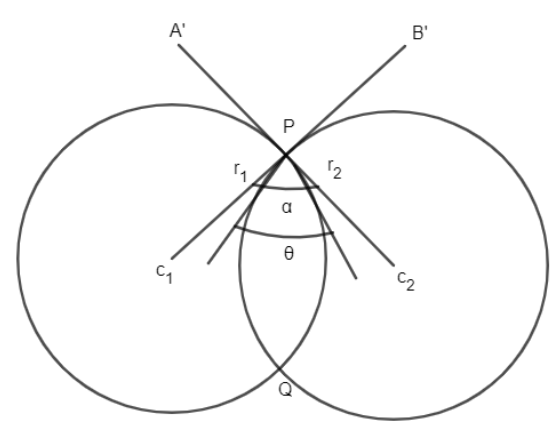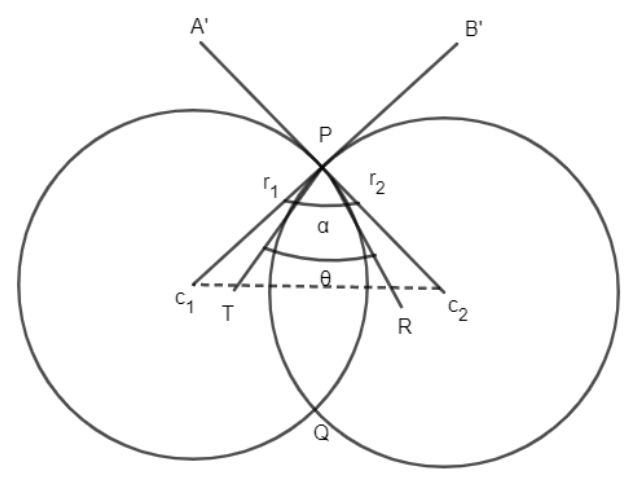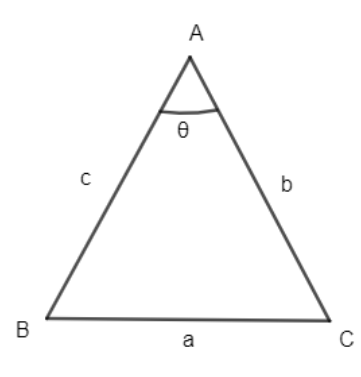
Find the angle of intersection of two circles?
\[{{x}^{2}}+{{y}^{2}}+2gx+2fy+c=0\]
\[{{x}^{2}}+{{y}^{2}}+2{{g}_{1}}x+2{{f}_{1}}y+{{c}_{1}}=0\]


Answer
561.3k+ views
Hint: To solve this question, we will, first of all, compute the centre and radius of both the circles using the formula \[c=\left( \dfrac{-g}{a},\dfrac{-f}{a} \right)\] and \[r=\dfrac{1}{a}\sqrt{{{g}^{2}}+{{f}^{2}}-c}\] and then we will calculate the distance between \[{{c}_{1}}\] and \[{{c}_{2}}\] by using the distance between two points formula, \[d=\sqrt{{{\left( {{x}_{1}}-{{x}_{2}} \right)}^{2}}+{{\left( {{y}_{1}}-{{y}_{2}} \right)}^{2}}}.\] Finally, we will use the formula of cos of the angle in a triangle to get the result.
Complete step-by-step solution:
We are given the two circles below.
\[{{x}^{2}}+{{y}^{2}}+2gx+2fy+c=0.....\left( i \right)\]
\[{{x}^{2}}+{{y}^{2}}+2{{g}_{1}}x+2{{f}_{1}}y+{{c}_{1}}=0.....\left( ii \right)\]
They are given as

If the circles intersect at P, then the angle \[\theta \] is the angle between the tangents to both the circles at the point P. \[{{c}_{1}}\] and \[{{c}_{2}}\] are the centres of the circles given by the equation (i) and (ii) respectively. And the standard equation of a circle is of the form
\[a{{x}^{2}}+b{{y}^{2}}+2gx+2fy+2hxy+c=0\]
where a, b, h, g, f and c are constants and the radius of the circle is given by
\[r=\dfrac{1}{a}\sqrt{{{g}^{2}}+{{f}^{2}}-ca}\]
And the centre of the circle is given by
\[c=\left( \dfrac{-g}{a},\dfrac{-f}{a} \right)\]
Comparing this theory with our given equation (i) and equation (ii) of the circle, we have the centre as
\[{{c}_{1}}=\left( -g,-f \right)\]
\[{{c}_{2}}=\left( -{{g}_{1}},-{{f}_{1}} \right)\]
And radius is given as,
\[{{r}_{1}}=\sqrt{{{g}^{2}}+{{f}^{2}}-c}\]
\[{{r}_{2}}=\sqrt{{{g}_{1}}^{2}+{{f}_{1}}^{2}-{{c}_{1}}}\]
Clearly, as visible by the above diagram, the distance ‘d’ between the circles is given by
\[d=\left| {{c}_{1}}{{c}_{2}} \right|\]
The formula of the distance between the two points \[\left( {{x}_{1}},{{y}_{1}} \right)\] and \[\left( {{x}_{2}},{{y}_{2}} \right)\] is given by
\[d=\sqrt{{{\left( {{x}_{1}}-{{x}_{2}} \right)}^{2}}+{{\left( {{y}_{1}}-{{y}_{2}} \right)}^{2}}}\]
Using this formula to find the distance \[d=\left| {{c}_{1}}{{c}_{2}} \right|\] we have,
\[d=\sqrt{{{\left( g-{{g}_{1}} \right)}^{2}}+{{\left( f-{{f}_{1}} \right)}^{2}}}\]
\[\Rightarrow d=\sqrt{{{g}^{2}}+{{g}_{1}}^{2}-2g{{g}_{1}}+{{f}^{2}}+{{f}_{1}}^{2}-2f{{f}_{1}}}\]
\[\Rightarrow d=\sqrt{{{g}^{2}}+{{f}^{2}}+{{g}_{1}}^{2}+{{f}_{1}}^{2}+-2g{{g}_{1}}-2f{{f}_{1}}}\]
Now considering the triangle \[{{c}_{1}}P{{c}_{2}}\] and the angle \[\alpha \] between \[{{c}_{1}}P{{c}_{2}}.\]

Now, if triangle ABC is given as below, where the angle \[\theta \] is \[\angle BAC,\] then if AB = c, AC = b and BC = a, then \[\cos \theta \] is given by the formula \[\cos \theta =\dfrac{{{b}^{2}}+{{c}^{2}}-{{a}^{2}}}{2bc}.\]
Applying this formula on the angle \[\alpha \] is given by
\[\cos \alpha =\dfrac{{{r}_{1}}^{2}+{{r}_{2}}^{2}-{{d}^{2}}}{2{{r}_{1}}{{r}_{2}}}\]
where \[\alpha \] is the angle \[\angle {{c}_{1}}P{{c}_{2}}.\]
Now, \[\theta \] is the angle \[\angle {{A}^{'}}P{{B}^{'}},\] this is so as vertically opposite angles are equal and \[\angle TPR=\theta .\]
\[\Rightarrow \angle {{A}^{'}}P{{B}^{'}}=\angle TPR=\theta \left[ \text{vertically opposite angles} \right]\]
Now, because \[{{A}^{'}}{{c}_{2}}\] and \[{{B}^{'}}{{c}_{1}}\] are tangles to the circles of the centre \[{{c}_{1}}\] and centre \[{{c}_{2}}\] respectively, then \[\angle {{B}^{'}}P{{c}_{2}}=\angle {{A}^{'}}P{{c}_{1}}={{90}^{\circ }}.\]
Finally, we have a full circle angle that is \[{{360}^{\circ }}.\]
\[\Rightarrow \angle {{B}^{'}}P{{c}_{2}}+\angle {{A}^{'}}P{{c}_{1}}+\angle {{A}^{'}}P{{B}^{'}}+\angle {{c}_{1}}P{{c}_{2}}={{360}^{\circ }}\]
\[\Rightarrow {{90}^{\circ }}+{{90}^{\circ }}+\alpha +\theta ={{360}^{\circ }}\]
\[\Rightarrow \alpha ={{180}^{\circ }}-\theta \]
Now, as \[\cos \alpha =\dfrac{{{r}_{1}}^{2}+{{r}_{2}}^{2}-{{d}^{2}}}{2{{r}_{1}}{{r}_{2}}}\]
\[\Rightarrow \cos \left( {{180}^{\circ }}-\theta \right)=\dfrac{{{r}_{1}}^{2}+{{r}_{2}}^{2}-{{d}^{2}}}{2{{r}_{1}}{{r}_{2}}}\]
Hence, the angle between the circle is given by \[\cos \left( {{180}^{\circ }}-\theta \right)=\dfrac{{{r}_{1}}^{2}+{{r}_{2}}^{2}-{{d}^{2}}}{2{{r}_{1}}{{r}_{2}}}\] where \[{{r}_{1}}\] is the radius of the circle \[{{x}^{2}}+{{y}^{2}}+2gx+2fy+c=0\] and \[{{r}_{2}}\] is the radius of the circle having equation \[{{x}^{2}}+{{y}^{2}}+2{{g}_{1}}x+2{{f}_{1}}y+{{c}_{1}}=0\] and d is the distance between the centre \[{{c}_{1}}\] and \[{{c}_{2}}\] of both the circles.
Note: Because \[\alpha \] is the angle between the centre \[{{c}_{1}}\] of the circle \[{{x}^{2}}+{{y}^{2}}+2gx+2fy+c=0\] and the centre \[{{c}_{2}}\] of the circle \[{{x}^{2}}+{{y}^{2}}+2{{g}_{1}}x+2{{f}_{1}}y+{{c}_{1}}=0.\] Therefore, we needed to calculate the value of \[\alpha .\] This \[\alpha \] will give the angle between two given circles. Also, in such cases always the angle from the centre of the two circles is measured.
Complete step-by-step solution:
We are given the two circles below.
\[{{x}^{2}}+{{y}^{2}}+2gx+2fy+c=0.....\left( i \right)\]
\[{{x}^{2}}+{{y}^{2}}+2{{g}_{1}}x+2{{f}_{1}}y+{{c}_{1}}=0.....\left( ii \right)\]
They are given as

If the circles intersect at P, then the angle \[\theta \] is the angle between the tangents to both the circles at the point P. \[{{c}_{1}}\] and \[{{c}_{2}}\] are the centres of the circles given by the equation (i) and (ii) respectively. And the standard equation of a circle is of the form
\[a{{x}^{2}}+b{{y}^{2}}+2gx+2fy+2hxy+c=0\]
where a, b, h, g, f and c are constants and the radius of the circle is given by
\[r=\dfrac{1}{a}\sqrt{{{g}^{2}}+{{f}^{2}}-ca}\]
And the centre of the circle is given by
\[c=\left( \dfrac{-g}{a},\dfrac{-f}{a} \right)\]
Comparing this theory with our given equation (i) and equation (ii) of the circle, we have the centre as
\[{{c}_{1}}=\left( -g,-f \right)\]
\[{{c}_{2}}=\left( -{{g}_{1}},-{{f}_{1}} \right)\]
And radius is given as,
\[{{r}_{1}}=\sqrt{{{g}^{2}}+{{f}^{2}}-c}\]
\[{{r}_{2}}=\sqrt{{{g}_{1}}^{2}+{{f}_{1}}^{2}-{{c}_{1}}}\]
Clearly, as visible by the above diagram, the distance ‘d’ between the circles is given by
\[d=\left| {{c}_{1}}{{c}_{2}} \right|\]
The formula of the distance between the two points \[\left( {{x}_{1}},{{y}_{1}} \right)\] and \[\left( {{x}_{2}},{{y}_{2}} \right)\] is given by
\[d=\sqrt{{{\left( {{x}_{1}}-{{x}_{2}} \right)}^{2}}+{{\left( {{y}_{1}}-{{y}_{2}} \right)}^{2}}}\]
Using this formula to find the distance \[d=\left| {{c}_{1}}{{c}_{2}} \right|\] we have,
\[d=\sqrt{{{\left( g-{{g}_{1}} \right)}^{2}}+{{\left( f-{{f}_{1}} \right)}^{2}}}\]
\[\Rightarrow d=\sqrt{{{g}^{2}}+{{g}_{1}}^{2}-2g{{g}_{1}}+{{f}^{2}}+{{f}_{1}}^{2}-2f{{f}_{1}}}\]
\[\Rightarrow d=\sqrt{{{g}^{2}}+{{f}^{2}}+{{g}_{1}}^{2}+{{f}_{1}}^{2}+-2g{{g}_{1}}-2f{{f}_{1}}}\]
Now considering the triangle \[{{c}_{1}}P{{c}_{2}}\] and the angle \[\alpha \] between \[{{c}_{1}}P{{c}_{2}}.\]

Now, if triangle ABC is given as below, where the angle \[\theta \] is \[\angle BAC,\] then if AB = c, AC = b and BC = a, then \[\cos \theta \] is given by the formula \[\cos \theta =\dfrac{{{b}^{2}}+{{c}^{2}}-{{a}^{2}}}{2bc}.\]
Applying this formula on the angle \[\alpha \] is given by
\[\cos \alpha =\dfrac{{{r}_{1}}^{2}+{{r}_{2}}^{2}-{{d}^{2}}}{2{{r}_{1}}{{r}_{2}}}\]
where \[\alpha \] is the angle \[\angle {{c}_{1}}P{{c}_{2}}.\]
Now, \[\theta \] is the angle \[\angle {{A}^{'}}P{{B}^{'}},\] this is so as vertically opposite angles are equal and \[\angle TPR=\theta .\]
\[\Rightarrow \angle {{A}^{'}}P{{B}^{'}}=\angle TPR=\theta \left[ \text{vertically opposite angles} \right]\]
Now, because \[{{A}^{'}}{{c}_{2}}\] and \[{{B}^{'}}{{c}_{1}}\] are tangles to the circles of the centre \[{{c}_{1}}\] and centre \[{{c}_{2}}\] respectively, then \[\angle {{B}^{'}}P{{c}_{2}}=\angle {{A}^{'}}P{{c}_{1}}={{90}^{\circ }}.\]
Finally, we have a full circle angle that is \[{{360}^{\circ }}.\]
\[\Rightarrow \angle {{B}^{'}}P{{c}_{2}}+\angle {{A}^{'}}P{{c}_{1}}+\angle {{A}^{'}}P{{B}^{'}}+\angle {{c}_{1}}P{{c}_{2}}={{360}^{\circ }}\]
\[\Rightarrow {{90}^{\circ }}+{{90}^{\circ }}+\alpha +\theta ={{360}^{\circ }}\]
\[\Rightarrow \alpha ={{180}^{\circ }}-\theta \]
Now, as \[\cos \alpha =\dfrac{{{r}_{1}}^{2}+{{r}_{2}}^{2}-{{d}^{2}}}{2{{r}_{1}}{{r}_{2}}}\]
\[\Rightarrow \cos \left( {{180}^{\circ }}-\theta \right)=\dfrac{{{r}_{1}}^{2}+{{r}_{2}}^{2}-{{d}^{2}}}{2{{r}_{1}}{{r}_{2}}}\]
Hence, the angle between the circle is given by \[\cos \left( {{180}^{\circ }}-\theta \right)=\dfrac{{{r}_{1}}^{2}+{{r}_{2}}^{2}-{{d}^{2}}}{2{{r}_{1}}{{r}_{2}}}\] where \[{{r}_{1}}\] is the radius of the circle \[{{x}^{2}}+{{y}^{2}}+2gx+2fy+c=0\] and \[{{r}_{2}}\] is the radius of the circle having equation \[{{x}^{2}}+{{y}^{2}}+2{{g}_{1}}x+2{{f}_{1}}y+{{c}_{1}}=0\] and d is the distance between the centre \[{{c}_{1}}\] and \[{{c}_{2}}\] of both the circles.
Note: Because \[\alpha \] is the angle between the centre \[{{c}_{1}}\] of the circle \[{{x}^{2}}+{{y}^{2}}+2gx+2fy+c=0\] and the centre \[{{c}_{2}}\] of the circle \[{{x}^{2}}+{{y}^{2}}+2{{g}_{1}}x+2{{f}_{1}}y+{{c}_{1}}=0.\] Therefore, we needed to calculate the value of \[\alpha .\] This \[\alpha \] will give the angle between two given circles. Also, in such cases always the angle from the centre of the two circles is measured.
Recently Updated Pages
Master Class 12 Business Studies: Engaging Questions & Answers for Success

Master Class 12 Economics: Engaging Questions & Answers for Success

Master Class 12 English: Engaging Questions & Answers for Success

Master Class 12 Maths: Engaging Questions & Answers for Success

Master Class 12 Social Science: Engaging Questions & Answers for Success

Master Class 12 Chemistry: Engaging Questions & Answers for Success

Trending doubts
Who was the first woman to receive Bharat Ratna?

Write a letter to the principal requesting him to grant class 10 english CBSE

Why is there a time difference of about 5 hours between class 10 social science CBSE

What is the median of the first 10 natural numbers class 10 maths CBSE

The Equation xxx + 2 is Satisfied when x is Equal to Class 10 Maths

Discuss the main reasons for poverty in India




